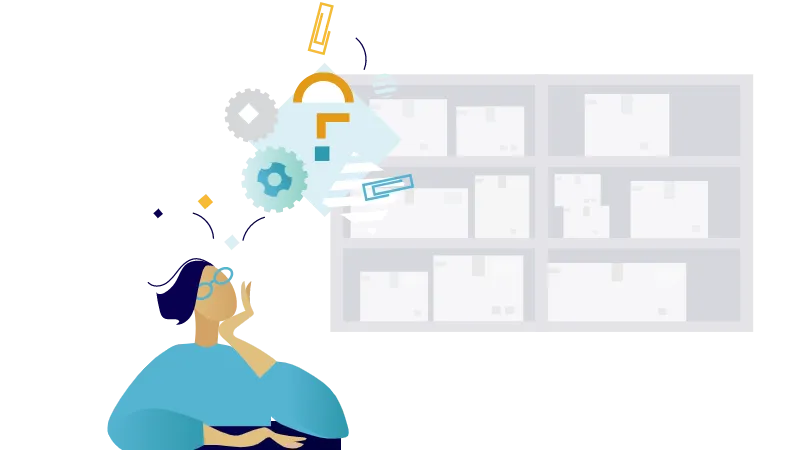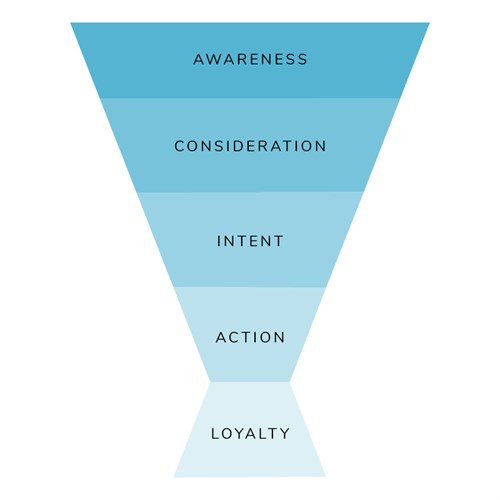Marketing Funnels - What does that mean?
Written by Amy Monaghan
May 2nd, 2021Other subjects...
successes selling online gifts challenges small business share meet the maker news technology
Marketing jargon can feel very overwhelming when you're just trying to make your small business work for you. So we've tried to explain the concept used in sales conversions of marketing funnels and how they can help you, without creating extra work.
This one is an interesting concept rather than a lot of work, and that has to be good news! But everything here goes back to knowing your customer - who are they, where to find them, what they want and how you provide it.
This is the basic setup of a marketing funnel. There are many variations of this, but it all comes down to similar component parts.

The first stage is generating awareness. This is arguably the hardest stage of your small business journey as you're trying to put yourself out there to new people. But the most common mistake people make is assuming that people already understand your business. They don’t. You need to introduce yourself, the business, the products, the ethos, anything which you think is obvious isn’t - you live it everyday and these people have only just found you, so what do they want to know and how are they going to find that information? Identify their emotional need for your product and explain how you solve that, be it the pain and frustration they have which you want to solve, or a sentiment that you’re trying to evoke, use your business descriptions and imagery to help them identify with you. Whether you’re trying to increase your following, generate more custom or get people to your next event, the principles remain the same - this stage isn’t about selling. You might choose to create online ads to grab attention, but at this point videos with a storytelling element are far more likely to gain you attention than a half price sale.
Once someone knows who you are, what you do and why they should buy from you, they move into the consideration stage. They might start to engage with your business, visit your website and learn more about your product. But they’re not yet sure about you, and may well still have several options to choose from. This is all about establishing connections and giving your business the edge over another. Show this potential customer that you can solve their problems, this isn’t about you it’s about what they need and why they can find it here. Product descriptions, customer reviews and more detailed information about your business can help to build that familiarity and trust which people want to see. Consider creating blog posts, how to videos, and content which establishes your expertise. The other thing that many people forget to do at this point is to show people your face! Buying from a small business is all about the person doing the work, and it’s what sets you apart from the big shops. Capitalise on that by making sure they know how your products are created, the love and care that goes into them, and how happy you are about making sales. At this point people might start to engage with you on social media, like your posts or make comments, be helpful, approachable and authentic. If you respond and someone else doesn’t, you’re doing better at making that connection.
So assuming that you have a product that someone wants to buy you’re now moving people down the funnel into the intent stage. At each part of the funnel you loose people, and the numbers get smaller each time, but this allows you to be more targeted. And it’s also where you need to use your channels most effectively. Identify questions that people frequently pose to you, and answer them for everyone. It’s only the bravest few that will reach out to you to ask the questions but many people might be thinking it. They’ll be visiting your product pages to make their considerations, so give people the answers to those problems you’ve identified. If you’ve already had contact it might also be the time to bring out that all important sales offer. We don’t advocate having money-off sales for the sole reason of making a few extra sales if it means you’re ultimately going to be loosing out. This is a business and you should treat it as such. But multi-buy offers, or the promise of free things with your order, can entice someone at this stage once they’re actively engaged. If you’re getting people to events then offer them something when they attend, or promise them an add-on. These don’t need to have monetary value, but a perceived added value is what you’re looking for. It could be gift wrapping, a send direct to recipient with a hand-written note, speedy delivery options, or exposure for their unboxing video. You know your market! At this stage people might be sharing your content, and even putting your item in the basket, you’ve just got to nudge them over the line.
Then you get to the action. Whoop, you’ve made a sale! This is what many people believe to be their end goal - you’ve achieved what you set out to, and all of the hard work is done and you can sit back and enjoy the cash... Well not quite. It is brilliant, and you should be celebrating, little dances are actively encouraged. The transaction might be complete, but that's not the end. A sale is just the start of your relationship with the customer, and it’s up to you to give them confidence in the choice they just made. Include a thank you note with your package, make sure it’s presented beautifully (imagine you were gifting this - what would you expect?) and encourage the customer to take another action. This might be to leave a review, we’ve already talked about how important these can be at the consideration stage, and also helps you to gauge their experience of your products. It might also be to make another sale. Include information about your other products, how to follow you, links to your website etc. you’re removing the barriers to them finding you in the future. Because...
…the most important part of this funnel is loyalty. If someone has left a review and they love your stuff, see what you can do to make them come back. You want them to talk about their purchase, and in doing so advertise your business to others. This is where the funnel starts to invert and that one customer might become many. They start to bring in other people for you and if they become returning customers too then you’re onto a winner. You could consider a returning customer offer, or a referral scheme, or just encourage those interactions on your social media channels and get everyone wanting to show the world that they have one of your latest creations.
So that’s the principle of how your marketing funnel should operate, and it probably doesn’t mean that you need to do anything other than show people the right content at the right time. Consider the customer journey. Put yourself in their shoes. And don’t assume that anyone knows anything about you - until you know that they do. Then that’s the time to switch your messaging. Using these techniques rather than just resorting to a flash sale could help you to build your business, whilst helping to retain those carefully calculated profit margins that can make a huge difference to the success of a small business.